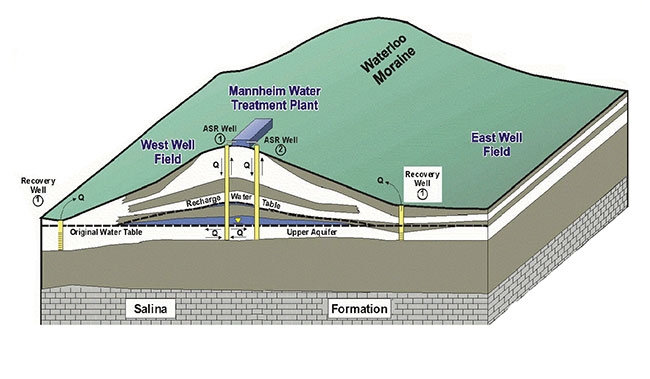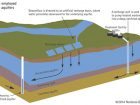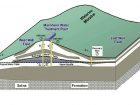
Features
Water Issues
Managed aquifer recharge
September 9, 2019 By Carolyn Camilleri
 Conceptual model of the aquifer storage and recovery (ASR) system used by Waterloo Region in Ontario. image courtesy Regional Municipality of Waterloo
Conceptual model of the aquifer storage and recovery (ASR) system used by Waterloo Region in Ontario. image courtesy Regional Municipality of WaterlooSimply put, managed aquifer recharge (MAR) is the process of taking water, typically excess surface water, and putting it into an aquifer for later use.
As Don Corbett, senior hydrogeologist for the Regional Municipality of Waterloo, explains, MAR is a fairly broad category, with roots going back to the ancient Persians, who captured water coming down off the mountains, detained it, and tried to get it to percolate into the ground.
“Any way you can slow down surface water or capture surface water, or even in some cases treated waste water, and kind of force it into the ground, that’s basically managed aquifer recharge,” Corbett says. “And there are lots of different ways you can do that.”
Within MAR, there are subsets, including flood MAR, which captures flood flows, detains the water in surface basins, then allows it to recharge aquifers. MAR processes are increasingly a best practice with new developments in sub-watershed and greenfield areas, where efforts are made to ensure the development doesn’t “shortchange” aquifers and nearby water features that depend on ground water. Another subset within MAR is ASR – aquifer storage and recovery – where instead of using recharge basins, treated water is injected into aquifers using flow wells.
“Some people think it’s a little bit like cheating the hydrologic cycle, but I liken it more to actively managing the hydrologic cycle in a way that we’re taking advantage of every little bit of surplus water that’s available to us,” Corbett says, noting that eventually it all finds its way back down to the bottom of the cycle. “We’re just recycling it a few times on its way and using it and then letting it go where it would normally go.”
Waterloo Region’s Mannheim Water Treatment facility has an ASR system and is located on a moraine – a natural geographic feature of course sand and gravel – with an aquifer beneath it. It’s an integral part of the long-term water plan for the region, which has relied on ground water for hundreds of years. While the first test well was constructed in 1996, the construction and detailed design of the expanded ASR system didn’t occur until 2003, with the full system of four ASR wells commissioned in 2005.
“These are the wells that do both injection and pumping, and they’re large, 16-inch wells, about 220 or so feet deep,” he says, adding that there are also three recovery wells for just extraction and pumping. The whole system is designed to produce roughly 23 million litres of water per day, and with the 60-day storage capacity, it’s equivalent to about 1,400 million litres of additional water that can be drawn upon during periods of high demand.
“Lots of people are surprised that we have an ASR system here, but it’s something this community got behind as part of our long-term water supply strategy,” Corbett says. “It’s preventing us from having to spend a lot more money to expand our treatment plant and look for new water sources, and even postpones the need for a pipeline. It gives us a lot of flexibility in the way we operate our water supply system, so that’s a huge benefit.”
GROWING INTEREST IN MAR
So why is MAR so rare in Canada? Because there has to be a need, as there is for landlocked Waterloo and for parts of B.C.’s lower mainland, but that may be changing.
“Generally, of the thousands of [MAR] projects that have been implemented worldwide, very few are in Canada but interest is increasing,” says Scott King, NGWA president and a hydrogeologist with Wood Environment and Infrastructure Solutions.
“Southern Ontario and Alberta seem to be areas where MAR development could have benefits,” says King.
MAR is a much bigger deal in the U.S., especially the southwest, where it has been proven to help with seasonal demand.
“When it’s hot and dry and access to surface water is less available, it helps sustainability, and the other term we often use is resiliency – being able to work your way through drought periods by having additional water banked in an aquifer, which you can draw on as needed,” King says.
Many examples of U.S. MAR systems could be looked at as models. Tim Parker, president of Sacramento-based Parker Groundwater and a nationally recognized ground water expert, has been working in the MAR space for years and offers a list.
“Being from California, I always point to Orange County Water District, Water Replenishment District of Southern CA, Santa Clara Valley Water District, SemiTropic, Kern Water Bank, Fresno Leaky Acres, to name a few,” Parker says, adding Texas (San Antonio ASR, El Paso ASR, and Desal), Idaho (Eastern Snake Plain), and Florida (multiple ASRs). “Oregon and Washington and Colorado all have good examples and lessons learned.”
Parker wrote about the Orange County Water District (OCWD) in his article “Managed Aquifer Recharge: California and Beyond” for the September 2017 issue (Vol 190, No. 5) of Water Resources Impact, an American Water Resources Association publication. The OCWD recharges approximately 300,000 acre-feet per year, using both percolation ponds and injection wells supplied by advanced treated recycled water, storm flows, and imported water. This replenishes the basin and maintains a hydraulic barrier along the coast to minimize seawater intrusion.
While there are some impressive examples in the U.S., Parker says not enough is being done to implement MAR.
“[There] needs to be a ‘paradigm shift’ in how we think about water management,” Parker says in an interview, explaining that current thought is to use available surface water first then ground water when less surface water is available. “I believe we need to redesign our water supply systems so we incorporate refilling aquifers – MAR – continuously when surface water is available, using all the methods – from direct to indirect, on stream, off stream, injection, and infiltration – in lieu of surface water use.”
Parker says, in general, where surface water is abundant, MAR is less prevalent, which may explain its rarity in Canada – for now.
Ken Hugo, a hydrogeologist with Groundwater Information Technologies in Calgary, says ASR has been discussed as a workable solution to some water issues in Alberta, including an overall shortage of surface water supply.
“We typically get a large amount of river flow in the late spring due to snowmelt and spring rains. Often, the flow in the late spring is 10 to 100 times the average flow throughout the year,” Hugo says, adding that in parts of southern Alberta, total water flow is sufficient but much of it is only in one month of the year and not available year-round. “It’s tough to see all this water leave the province in June and to see the creeks and rivers turn to a trickle in early fall or winter.”
One solution is dams, but dams have high costs and reservoirs take large areas. Dams are also politically problematic.
“We are trying to build a flood control dam west of Calgary, but the dam is meeting a lot of opposition,” Hugo says. “So an alternative is pumping the excess water into an aquifer during the late spring and withdrawing it over the year.”
Hugo says there are aquifers in the area that would likely be suitable, typically, buried valley aquifers – former valleys filled in with a combination of sands, gravels, silts, and clays – noting that proper identification of a suitable buried valley aquifer would have to be made.
“Society tends to respond to the most recent crisis – in Alberta, we had a severe flood in 2013 so most of the emphasis is on flood effect mitigation – but I have talked to a few hydrologists, and I am of a similar opinion, that a drought is much more worrisome in Alberta,” Hugo says. “I would foresee that ASR is thought of as something we should consider.”
ISSUES AND BENEFITS
MAR projects are not without their challenges. One of them is the interaction between the geochemistry of the water and the minerals in the materials in the aquifer.
“It is important to understand how they will react, because there can be some chemical reactions,” King says. “Those sorts of issues need to be looked at, but they can be understood and dealt with without too much difficulty.”
Parker also points to the importance of managing the differences in source water and aquifer water. “There will always be water quality changes and determining whether those are significant and unreasonable comes into play and requires iterative bench-to-pilot scale efforts to prove the recharge project before major capital is invested, especially for public agencies.”
In addition to being mindful of water chemistry, Corbett says monitoring aquifer levels is important to ensure there’s no negative impact on the aquifer. He adds that some unique challenges may be associated with ASR permits. “Essentially, the permits are set up to almost be revenue neutral, in that you’re only withdrawing the same volume that you’re putting in.”
Hugo says a lack of clear regulatory guidelines for ASR projects creates some uncertainty about how onerous the approval process would be on a project.
However, changing demand may prompt action.
“I think as demand [for water] increases, and water resources come under more stress, then people start looking to ways to maintain their aquifers,” King says. “From our point of view as ground water people, we think there’s a resource here that can be developed in a cost-effective way that can help in the sustainability in ground water supply.”
For example, consider the cost of building a surface water reservoir or a dam, compared to the cost of wells and pumps to put water in the ground.
“There’s a real cost benefit to look at MAR as a way to go in some places,” King says.
MAR may also be a good consideration for smaller, localized activity, King says, naming Lake Mead and Lake Tahoe, where water loss is significant. Corbett concurs, saying ASR projects can start at any scale.
“The rule of thumb I’ve learned through my work with ASR is that you start small, learn as you go, then expand as needed,” Corbett says. “You could start with just one well, and you could have that one well down close to one of the rivers. In the winter or spring time, where there’s an excess flow in that river, you can take some of that water and you can inject it in your aquifers. And then in the hot, dry summer, when you need additional water, you could withdraw that water from the well and use it.”
As for how these types of projects impact well drillers, Hugo says any ASR project would require a large amount of work from drillers: drilling and installing wells (injection/production wells and observation wells) and pumping tests to describe aquifer conditions, as well as long-term well and pump maintenance.
Corbett notes that the dual-purpose ASR wells have a value system called a Baski downhole flow control valve, but otherwise, the wells are like any other well, though they can be fairly deep sometimes. “Any water supply driller that’s set up to do that could drill ASR wells.”
The NGWA sees MAR as a strategic area of work for the association and for society in being able to sustain and manage aquifer systems. Moreover, it’s a process that can involve all their members: scientists, who would develop understanding of the aquifers and the properties; drillers, who would drill the wells and create the screens and ways to recharge the aquifers; and manufacturers and suppliers, who deal with the pumps, piping, and materials to get the mechanics working.
“All of us can work together to do this,” King says. “To us, it’s something that our members can really contribute to, in terms of water resources and ground water, in particular.”
RESOURCES FOR MORE INFORMATION ON MAR
“Global Inventory of MAR Schemes,” created by the International Groundwater Resources Assessment Centre based in Delft, the Netherlands, is a portal containing information on about 1,200 MAR case studies from more than 50 countries.
“Managed Aquifer Recharge: A tool to replenish aquifers and increase underground water storage” is a downloadable factsheet of basic, public-friendly information about MAR written by Katja Luxem in September 2017 for the American Geosciences Institute.
RESTORE: Research for Subsurface Transport and Remediation, a research group out of Western University in London, Ont., has a number of water remediation projects underway, including one in Bangladesh, using a type of MAR called aquifer storage, transfer and recovery (ASTR), where water is injected directly into the aquifer through a well and extracted at a distance to aid in bacteria removal.
“Aquifer Storage and Recovery: Best Suggested Practices” by the National Ground Water Association provides guidance for those considering getting involved in MAR or ASR projects.
“Recharge Roundtable Call to Action: Key Steps for Replenishing California Groundwater” is a report, published in 2018, that aims to identify the changes needed in infrastructure, knowledge, and institutions to substantially increase recharge in California within approximately the next five years. The report can be downloaded from http://ucwater.org/rechargeroundtable.
Carolyn Camilleri is a Toronto-based writer, editor, and content strategist. She has been writing for consumer and trade magazines, as well as businesses and organizations, for more than 15 years.
Print this page

